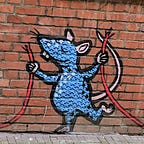Rickey’s Fishpond
Brooklyn Dodger executive Branch Rickey is best remembered for engineering Jackie Robinson’s integration of Major League Baseball in 1947. That was indeed his greatest contribution to the game, but hardly his only one.
With the St. Louis Cardinals in the 1920s, he began the transformation of minor league teams from independent local businesses to talent pipelines for the majors — what we know today as the farm system. And in 1947 Rickey hired a full-time statistician, Allan Roth, to study player performance. Roth tracked how players did in day games and night games, against lefties and righties, and in various pitch counts. He showed Rickey that star hitter Dixie Walker, a left-hander, was poking more balls to left field, suggesting he wasn’t getting around on the fastball anymore. That winter Rickey traded Walker to the Pittsburgh Pirates for Billy Cox and Preacher Roe, who became key parts of the great Dodger teams of the 1950s. After a decent 1948, Walker had an ugly, career-ending 1949, justifying Rickey’s credo that it was better to trade a player a year too early than a year too late.
In Rickey’s time, baseball teams were family businesses run by the owner and his cronies. Today they’re corporate juggernauts run by data crunchers. Since the 1970s, teams have improved themselves by pursuing free agents and proven veterans. But the data crunchers are taking front offices back to Rickey’s formula: develop a core of talented young players through the farm system, hold them through their prime (generally defined as ages 27–30), and then dispose of them before they become bad investments.
This is why quality free agents like starting pitcher Dallas Keuchel, who won the Cy Young Award in 2015, and reliever Craig Kimbrel, an all-star the last three seasons, are having trouble finding jobs. After all they’ve achieved, they feel entitled to multi-year contracts at top dollar. But Keuchel is 31, and Kimbrel will turn 31 in May. If you’re a good team in need of one more pitcher to reach the post-season, you might find it worthwhile to sign them. But if you’re already a contender — or, like most teams, not a contender — there’s little incentive to offer them an expensive, multi-year deal for diminishing returns.
Keuchel and Kimbrel are too good to sit on the sidelines. They will almost certainly sign contracts, albeit not for the years or dollars they expected. But what of baseball’s so-called middle class — decent but not great veteran players — on the wrong side of 30? Branch Rickey’s brutal logic threatens their careers.
The San Francisco Giants serve as the cautionary tale. A decade ago, the Giant farm system developed a core of young players that produced three World Series championships in five years. Under the collective bargaining agreement with the Major League Players’ Association, teams can pay players anything at or above the minimum wage (around $550,000) during the players’ first three years, then arbitrate salary the next three years. After six years of service, the players can become free agents. Instead of limiting their commitment to their core players’ first six years, which usually encompass the players’ peak ages, the Giants signed several to lucrative, more-or-less lifetime contracts. The consequence? In 2018 they had the second highest opening day payroll; their hitters were the oldest (tied with the Seattle Mariners, who had 44 year-old Ichiro Suzuki); their pitching staff was the fifth oldest; and they finished a dismal 73–89. With those core players another year older, they figure to suffer a losing 2019 also.
The San Francisco Giant model is based on a Brooklyn Dodger model — not Branch Rickey’s, but Walter O’Malley’s, who kept Rickey’s core players into the mid-1950s and flourished. Fans get to root for their favorites year after year, a financially sound stratagem: contrast the Giants’ popularity with that of the revolving-door Oakland Athletics. As the Dodgers’ core players aged, though, O’Malley realized he was in for several losing seasons, a factor in his move to Los Angeles; the new fans were likely to come to the park no matter how bad the team. (The Dodgers finished seventh in 1958, their first year in LA, but ranked second in attendance.)
The Giants’ new head of baseball operations, Farhan Zaidi, will move the team to the Rickey model. Will he succeed? Back in the 1930s and 40s, only Rickey was following the Rickey model. That’s how he was able to gull owners like Pittsburgh’s John Galbreath into overpaying for fading stars like Dixie Walker, and why Harold Parrott, travel secretary and publicist for Rickey’s Dodgers and author of the unjustly neglected The Lords of Baseball, called the major leagues “Branch Rickey’s fishpond.” Now everyone is working that fishpond, making it harder for any one angler — no matter how much data he crunches—to outdo the others.
